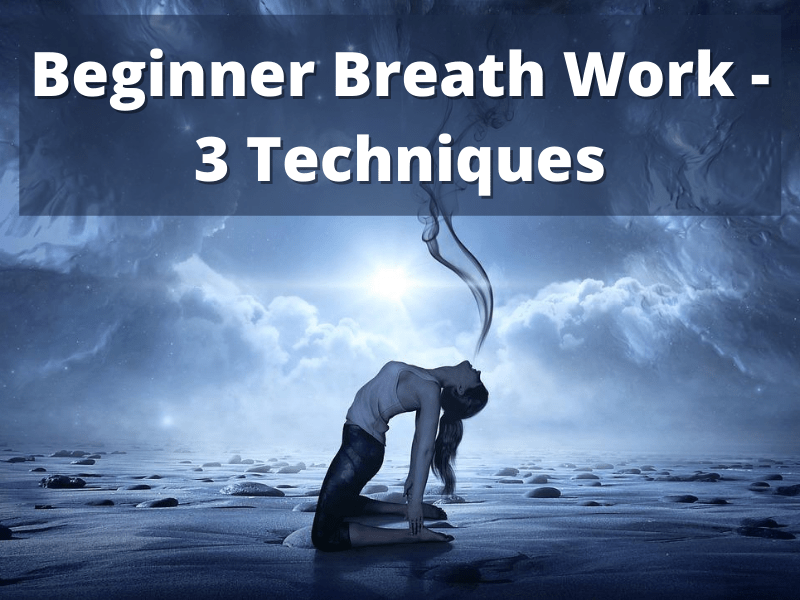Meditation can be difficult. It requires sitting still and being present in the moment, which can be especially hard if you have a lot on your mind. But many people find that practicing meditation has a positive influence on their mental and physical health.
Breathwork is a form of meditation that trains our focus by having us concentrate on the sensations of breath and allowing thoughts to come and go without judgment. Besides being an active form of meditation, it also allows us to disconnect from the mind and be guided by our heart.
 Unhelpful thoughts, beliefs, and memories get released when we breathe out. This gives us the feeling of being whole again and being able to better handle stress, anxiety, or lingering trauma.
Unhelpful thoughts, beliefs, and memories get released when we breathe out. This gives us the feeling of being whole again and being able to better handle stress, anxiety, or lingering trauma.
There are a ton of different breathwork techniques out there, each with its own unique purpose and effect on the body. Here are three you can start off with – two beginner options and one for advanced use – and some tips on when to best use them.
The 4-7-8 breath For when you feel overwhelmed
Dr. Andrew Weil’s 4-7-8 breathing technique is great for relaxation on a daily basis. It slows the beating of your heart, brings your consciousness to the present moment, and calms your central nervous system. You’ll also feel an immense sense of calm and peace
This breath will help with feelings that are too strong to manage. It can help with anxiety, anger and overwhelm. You should also practice this before sleeping to improve your sleep quality.
Using meditation during your breaks can improve self-knowledge, as well as your mental and physical stability, since it teaches the body not to take in external stimuli so quickly. Furthermore, by practicing each day you’ll be able to create space before the next inhale, which will allow time for releasing excess energy and thought from the body.
 How to do it:
How to do it:
One traditional way of doing 4-7-8 breathing is to empty your lungs, breathe in through your nose for 4 seconds, hold for 7 seconds, and exhale through the mouth for 8 seconds. The whole thing should be repeated at least four times.
As you breathe in, imagine the earth’s grounded and nourishing energy coming up into your body.
As you take a deep breath, think about breathing up the central axis of your body (starting from the base of your spine through to the top of your head) and pulling any energy that does not serve you with it.
Keep breathing deeply as you exhale over 8 seconds. Imagine that any excess energy is leaving your mouth, while picturing white light filling these areas before pouring back down to your feet and towards the ground below you.
When you need an energy boost: The 4-4-4-4 breath.
Box Breathing comes from the Navy SEALs and is also known as Square breathing, or 4-4-4-4 breath.
This deep breathing technique is known for slowing down your heart rate, improving concentration and heightening efficiency as well as stress relief. The best time to use it is in the morning – to get you going for the day or before a big project.
To try this technique, start by breathing out all the air from your chest. Hold your breath for 4 seconds, then breathe in through your nose for 4 seconds. Hold your breath again for 4 seconds, and repeat that 2 more times.
When inhaling, think about the earth element of the north. This will nourish your physical body.
As you hold your breath, imagine the breath swooping through the mind like the wind element of the east, clearing out any thoughts that do not serve and keeping the thoughts that do serve you.
As you exhale out of the mouth, imagine the fire element of the south that resides in the center and heart of our body, burning any thoughts and feelings in our emotional heart and belly to release through the mouth.
As you hold your breath for the last 4 seconds, ask kindly your higher self, a gentle feminine water element in the west, to come into your presence and be with you during this time.
When you feel yourself getting worked up: The 5-5 breath.
While our natural tendency is to breathe at a rate of two or three seconds per minute, Coherent Breathing, or the 5-5 breath, is a controlled and conscious breathing practice that slows down our breathing to 4 seconds and then 5 seconds. The 5-5 breath is ideal for an overall sense of calm and can be practiced throughout the day.
 How to do it:
How to do it:
To start, focus on the natural rhythm of your breath to obtain a baseline length of each inhale and exhale. Then for 1 minute, breathe in for 4 seconds, and exhale for 4 seconds. Then repeat for 5 seconds, then repeat for 6 seconds, and if you want to, gradually expand to 10 seconds. Start with 5 minutes total and work your way up over time to 20 minutes.
Imagining the earth energy rising up in to your body and then releasing the thoughts, emotions, and physical sensations you no longer want to hold on to by exhaling.
When it comes to identifying what treatment is right for you, the first thing to identify is the issue your struggling with and what you want it to do. There’s no one-size-fits-all, so just experiment with different techniques until something feels good. When it comes to meditation, there are a number of different forms to explore. Which one works best will depend on your personal preferences and needs. Pay attention to what you think feels right in order to provide the most powerful and meaningful practice.



